Contents
Limoncello! This sweet, tart and refreshing Italian after-dinner digestif can be a terrific, incomparable treat. But quite often, when you try one of the store copies, at the bottom of the glass you find only sugary sweetness and the complete absence of that freshness for which the inhabitants of the southern regions of Italy so fell in love with the liquor. Here’s the good news: Limoncello is super easy to make at home and then fine-tune to your liking!
Limoncello is a sweet Italian lemon liqueur with a strength of 20 to 37%. It has been prepared mainly in southern Italy for at least a hundred years, mainly in the regions around the Gulf of Naples, the Sorrento Peninsula and the Amalfi Coast, as well as on the islands of Ischia, Capri and Procida. It is also popular in Calabria, Abruzzo, Basilicata, Apulia, Sicily, Sardinia, Liguria, Menton in France and the Maltese island of Gozo. In any case, that’s how it used to be. Today, only an inveterate teetotaler has not heard of limoncello.
In the homeland of the liquor, the so-called Limoncello di Sorrento IGP is considered a classic. It is traditionally made with the zest of Femminello St. Teresa lemons (better known as Sorrento lemons – they are listed in the IGP register, an analogue of the European PGI system), which are characterized by a rough, wrinkled peel, rich in essential oils. Lemons must be grown in the Campania region, between the cities of Vico Equense and Massa Lubrense, or on the island of Capri. Grown under the canopy of chestnut trees that protect the young shoots of lemon trees from precipitation.
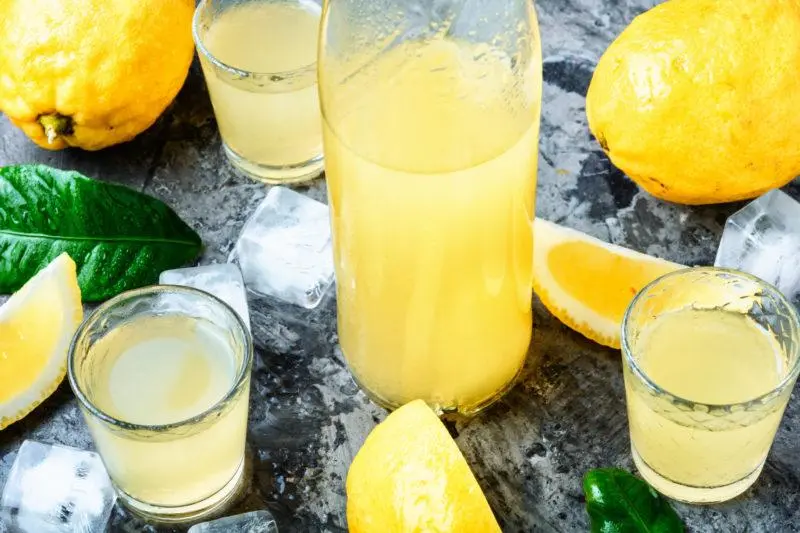
Lemons are picked by hand, washed thoroughly, and then the zest is cut from them without white albedo. The zest is soaked in alcohol (a process called maceration) for about one month, after which the fragrant infusion is mixed with sugar syrup. With syrup, the drink rests for about a month, after which it is filtered and poured into bottles. There is no ultimate recipe. How many families in Italy prepare limoncello, so many ways to prepare it. The main thing is to remember the algorithm of actions, and then experiment, experiment and experiment again! But, of course, you should start with a recipe that is considered a classic in the homeland of the liqueur.
Traditional Limoncello Recipe
Recipe for Italian lemon liqueur inspired by Limoncello di Sorrento IGP.
A type liquor
Kitchen Italian
Prepare 7 days
Cooking 30 minutes
Total 7 days 30 minutes
Ingredients
- 8-10 large lemons
- 1 л grain alcohol (95,6%)
- 1-1,2 л clean water
- 600-800 г sahara
Instructions
Rinse the lemons well, but rather pour boiling water over them so that the wax falls behind, and then rub them with a dense, rough cloth. Then remove the zest: you need to remove only the yellow part of it, without the white subcutaneous (albedo), which gives bitterness. The easiest way to do this is with a potato peeler or a sharp vegetable knife. You can also use a small grater.

Put the zest in a jar of a suitable volume, fill it with high-quality grain alcohol, then close the jar tightly and leave to infuse in a dark, cool place. In order not to get confused with the terms on the bank, write the date.
It is recommended to insist the zest on alcohol for 3 to 20 days. As practice shows, after a week of maceration, nothing new happens with lemon essence, so it makes no sense to delay this stage. In order for the zest to release the essential oils completely, the contents of the jar must be stirred every day by shaking.
When the alcohol turns yellow and the lemon peel turns pale and brittle, strain the tincture through a sieve or several layers of gauze into a clean container with an airtight lid. You can start making syrup.
In a saucepan, mix water and sugar, heat over medium heat, stirring constantly, until sugar is completely dissolved. Once the sugar has dissolved, remove the syrup from the heat and let it cool to room temperature. Add it to the lemon macerate and mix thoroughly. The liquor will become cloudy. Don’t be alarmed, this is how it should be – the essential oils have emulsified, that is, they have been released from the alcohol that held them (a similar effect is observed when absinthe and other similar drinks are diluted with water, it is known in the world as the “ouzo effect”).
Pour homemade limoncello into clean, sterile bottles with airtight lids and leave in a cool, dry place away from sunlight for 30-40 days to rest. Now the liqueur can be stored in the refrigerator or freezer and enjoy its fresh, bright lemon taste.

On the way to the perfect limoncello
Obviously, lemons play a crucial role here and their choice must be approached thoroughly. It is good if these are lemons from farmers who do not use pesticides or use them in minimal quantities. In any case, before removing the zest, they must be thoroughly washed under running water, even with a stiff brush. According to the experience of the Sorrentines, the best homemade limoncello comes from fruits with a thick, wrinkled skin, and their zest, even without albedo, should be slightly bitter.
Choosing the Right Proportions
The balance of ingredients is as important as the lemons themselves. The Italians left a few clues about this. For example, for every 100 ml of alcohol, it is recommended to take about 30 g of lemon peel – a bright, fresh lemon taste is guaranteed. To get a liquor of medium strength, in the region of 35%, you should use about 120% water in relation to alcohol and about 80% sugar to get a drink with a sugar content of 30%. Such a limoncello, with a strength of 35-38% and a sweetness of 300 g / l, is considered a classic in southern Italy.
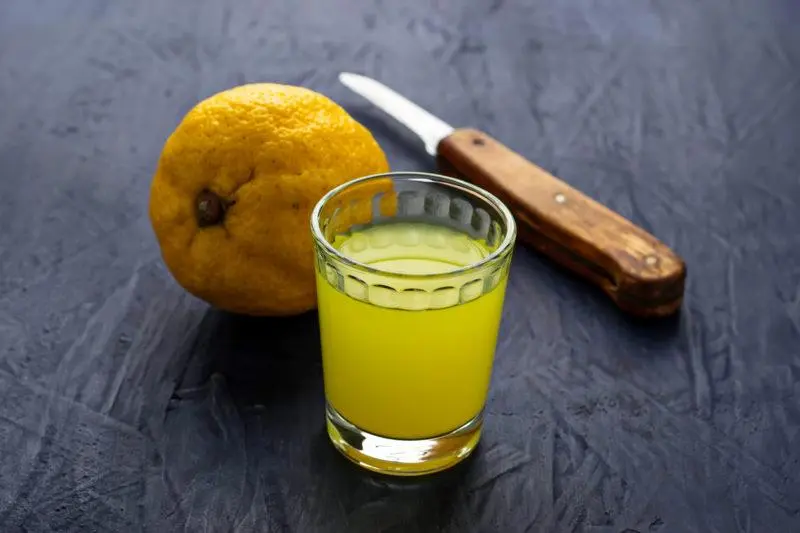
Math games
There is a very simple and fairly accurate way to determine the strength of the future liquor. To do this, you can use the following formula:
strength of liquor = (volume of alcohol / total volume) * strength of alcohol
For example, let’s apply this formula to our basic recipe at the maximum task of water and sugar for syrup. Every 100 g of sugar will increase the volume of the drink by about 60 ml, i.e. 800 g of sugar = 480 ml of increased total volume (total volume = 1000 ml of alcohol + 1200 ml of water + 480 ml from sugar). We get: (1000/2680) * 95,6 = 35,7%. Suits us.
Now it is easy to answer a fairly common question: is it possible to use vodka instead of alcohol? Yes, but: (1000/2680)*40 = 15%. Not really, right? What should be done? That’s right, reduce the amount of water and, accordingly, sugar, for example, to 300 ml and 400 g. Then: (1000/1540) * 40 = 26%. Already better, while the sugar here is about 260 g / l (divide the volume of sugar in grams by the volume of the drink in liters). Using this formula, adjusting the liquor to your liking is very simple.
For starters, I recommend using less sugar and more water. A good start: for 1 liter of alcohol, take 1,1 liters of water and 660 g of sugar (strength ≈ 37%, sugar ≈ 26%). Women will definitely appreciate a less strong version with the same taste: for 1 liter of alcohol – 1,6 liters of water and 800 g of sugar (strength ≈ 30%, sugar ≈ 26%)
Important! The flavoring components of lemon peel are very susceptible to light, heat and acidic environments. For this reason, limoncello, both during preparation and after, is recommended to be kept away from direct sunlight and always in a cool place. Ideal storage conditions for the finished liquor: in the refrigerator or freezer, in sealed dark glass bottles. Adding lemon juice will not only shorten the shelf life of the liqueur (and it’s best to use it within 1 year), but it will also speed up the oxidation of aromatic essential oils – the freshness of the lemon will disappear very quickly!
Other nuances and tips:
- Vodka, with the recalculation of proportions, can be used, but with an increase in the maceration period, at least up to 20 days, preferably up to a month. True, you should not expect the same bright taste from such a drink as from limoncello with alcohol – for normal extraction of essential oils, you need at least 50%, preferably 70% alcohol at least. With a treasury, it is better to prepare lemon vodkas.
- In Italy, strong grappa is often used as an alcoholic base. Not a bad option, but for a really clean lemon flavor, opt for a high quality, neutral grain alcohol.
- Sometimes an oil “cap” (film or lumps of yellow color) forms on the surface of the liquor. For me personally, this is an indicator of quality lemons and I don’t touch it. If it bothers you, just filter the drink through a cotton filter (funnel with a cotton swab or disc).
- According to a similar recipe, you can prepare other liqueurs based on citrus zest: orange, grapefruit, lime, pomelo, etc. Sometimes it turns out very interesting.
- Milk can be used instead of water. Then you will get creamy limoncello, a digestif no less popular in Italy.
What to do with leftover lemons?
A topical question for many, which is rather strange, because usually the fantasies of most drinkers are not taken away (ha ha).
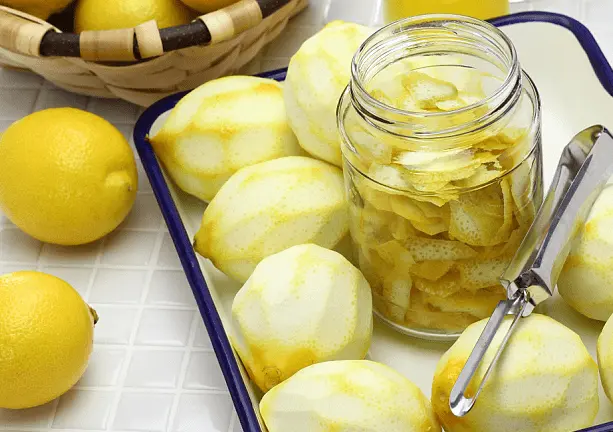
For a start:
- prepare delicious, real lemonade, lemon jelly or any other dish or drink with lemon juice;
- freeze juice in ice cubes – these cubes can be used for making cocktails, salad dressings and other culinary purposes;
- prepare a sour mix and prepare a huge number of cocktails with it, including homemade limoncello;
- use juice for cosmetic and household purposes (lemon juice is an excellent degreasing and odor-killing agent).
This is one of the obvious options. You can also make delicious jam:

lemon jam
- 6 peeled lemons
- 650 g sugar
- 60 ml of water
- 1 large apple
Remove the remaining albedo from the lemons, finely chop and remove the seeds. Mix in a saucepan with sugar and water, leave for 24 in the refrigerator. Then add a pitted apple cut into 4 parts, but with a peel, and cook over low heat for 45-50 minutes. Carry out the classic jam test on a saucer. Transfer the finished jam to sterile jars, which must be rolled up and placed upside down until cool. Ready!
… or a classic Sicilian dessert drink with the beautiful name Granita (Granita):

Granite
- 500 ml lemon juice
- 1 liter of clean water
- 300 g sugar
Prepare syrup from water and sugar, cool. Add lemon juice, mix well, add more sugar if necessary. Pour the mixture into a large glass container and place in the freezer. Every 20 minutes, the dessert should be stirred with a wooden spoon until a creamy mass with tiny ice floes is obtained. Serve on a hot summer day with a sweet bun. Ready!
… or “Drunken Lemon” according to the recipe of Italians:

drunk lemon
- peeled lemons
- quality grappa or chacha
- granulated sugar
- whole cloves
With a sharp knife, remove the albedo from the lemons and cut into thin slices 3-4 mm thick. At the bottom of a jar with a volume of 300-500 ml, layer lemons with sugar: a layer of lemons – 2 tsp. sugar – a layer of lemons – sugar, etc. At the end, add a couple of clove buds and pour grappa or chacha to the top. Send the jar to the refrigerator for 1-2 months, after which the lemons can be consumed in the appropriate atmosphere, washed down with delicious grappa nectar. Ready!
By the way, the pale zest left after maceration can also be used. But the process is quite laborious. First you need to lay it out on paper towels or a clean cloth and leave to dry for 1-2 days. Periodically, the zest needs to be stirred. Then put on a baking sheet and send to the oven, preheated to +80..+100оC, about 10 minutes. Turn off the oven and leave the door open to allow the steam to escape. Repeat the procedure with the oven until the pieces of zest begin to break easily between the fingers. Now the zest can be crushed: first in a blender, then in a coffee grinder. The resulting powder can be used as a flavoring for cookies, pies, creams, etc.
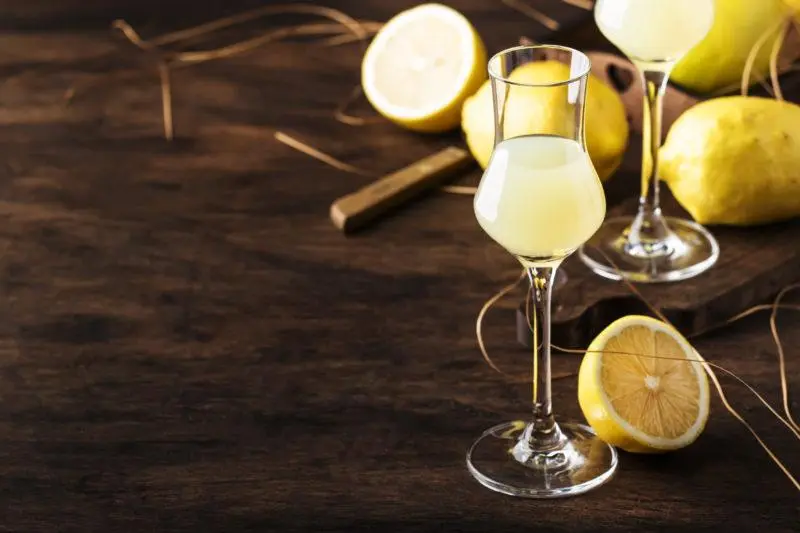
And home-cooked limoncello should be consumed as intended, preferably as it is customary to do on the sun-drenched shores of Italy. Traditionally, it is served very chilled (straight from the freezer) as an after-dinner digestif. Along the Amalfi Coast, lemon liqueur is drunk from small ceramic shots, which are also sent to the freezer for a couple of hours. There, such a pile became part of a whole ritual, akin to coffee, as a mandatory attribute after important lunches or dinners. Recently, limoncello has also settled in kitchen cabinets and bar shelves, as an ingredient in fruit salads, ice cream, confectionery and numerous cocktails.










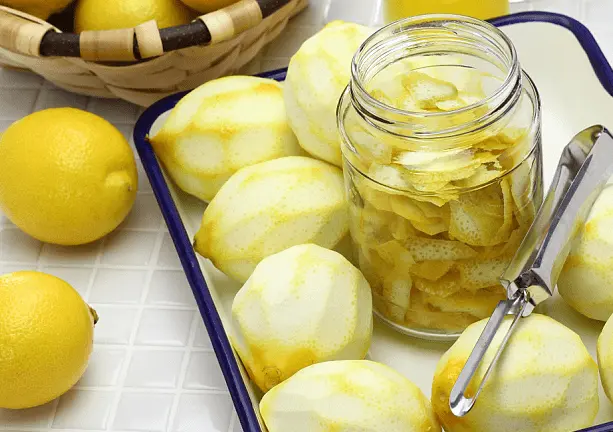
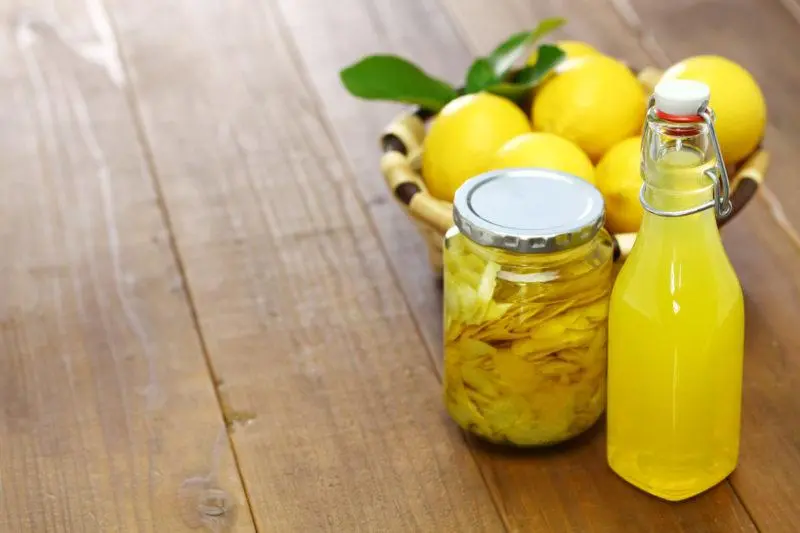
La formula, recomano aquesta es mes senzilla al meu pensar:
(V1xG1)+(V2+G2)/V1+V2=GF%
V1= volum inicial alcohol
V2=Volum aigua
G1=grau inicial alcohol
G2= grau aigua=0
GF= grau final